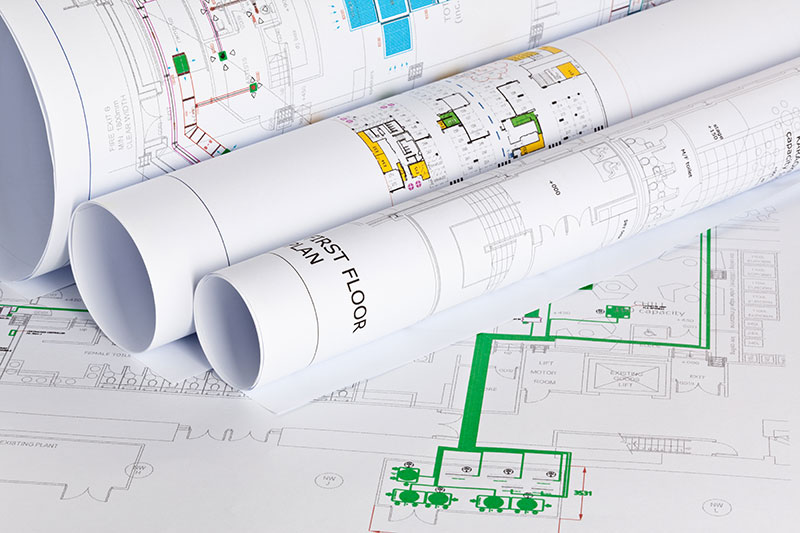As-built drawings represent the finished structure of a building. They reveal any changes made during the construction process and provide detailed information about the final building plans. Architects or construction engineers create as-built drawings to record any deviation from the building’s initial design in a construction project. As-builts are essential for every building project.
Also, construction professionals create and print high-quality as-built drawings for various reasons, such as planning renovations, building maintenance, bidding for projects, and making future upgrades to a building. It is important that contractors print and document every step of the construction process.
Here, we’ll look at what as-built drawings are, why they are important construction drawings, and every other thing you need to know about them.
What are as-built drawings?
As-built drawings are construction documents that monitor changes made to the original building plans in the course of a construction process. These drawings are used when there are new additions to the initial layout or plan of a structure. I.e., they document the existing layout and structure of the building. They are also called “as-is drawings,” existing drawings, or redline drawings.
For instance, if a contractor decides to resize an entryway during construction due to unavoidable developments, they must record this in the as-built drawings. This will help others involved in the project to understand the final building plans by indicating the changes made.
Paired with the as-built drawings, architects or contractors also need some additional drawings like cross sections, exterior elevations, reflected ceiling plans, and so on to fully understand the existing conditions of a building.

Why are as-built drawings important?
As-builts are among the essential construction drawings to have in print. Construction teams, owners, and stakeholders can benefit from as-built drawings in the following ways:
- Maintenance: As-built drawings provide relevant information about the buildings’ condition. This will guide building maintenance facility managers, engineers, or contractors who will make future changes and additions to an existing system.
- Corrections: Architects and engineers can use as-built drawings to put a final touch on their designs. As a result, they can make up for errors that slipped through the design phase.
- Renovation: Construction teams can use as-built drawings to understand existing building conditions when executing renovation projects.
- Ownership: As-built drawings will provide property owners and developers with the information they need about the finished buildings. It’s also helpful for new owners in the event of an ownership transfer.
- Save cost: With as-built drawings, construction teams can easily onboard new members without doing any damage to the existing system. They also have all the information they need to fix issues that might have otherwise cost a lot to resolve.
What you’ll find in as-built drawings
As-built drawings come with supporting documents in the form of written notes and relevant photographs. Some of the key components your as-built drawings should have include:
- Date: Whenever any change is made, the date is recorded.
- Location changes: Any changes made to the placement of windows, doors, plumbing systems, HVAC systems, and other major components.
- Dimension changes: Changes made to building dimensions.
- Obstructions: These are impediments encountered and the techniques used to tackle them.
- Changes to materials: Any change in the type, size, and location of various materials used in the construction process.
- Installation adjustments: Changes made when installing important building components like electrical, plumbing, and HVAC.
- Changes to fabrication: All changes made when fabricating elements like beams, staircases, and columns.
- Inspection changes: any changes made as a result of inspection feedback.
- Shop drawings and appendices.

Types of as-built drawings
There are different types of as-built drawings. These drawings are classified based on the systems they focus on, the Level of Detail (LOD), and the part of the structural documents (roofs, elevations, sections, etc).
Standard Drawing Set
A standard as-built drawing set is required when a property owner plans a simple remodeling project or wishes to add an extra unit to their property. This as-built drawing set includes:
1. Floorplans
The as-built floor plan indicates the doors, windows, stairs, exterior, and interior walls. It indicates the layout of various parts of the building and furniture and details all the equipment in each space.
Floor plans include details like showers, sinks, toilet seats, kitchen equipment, etc. As-built floorplans are very useful for interior renovation projects.
2. Roof Plan
This plan reveals the roof outline and indicates how it hangs over the walls beneath. It also includes information about the vents, mechanical equipment, and roof slope.
Roof plans help architects and structural engineers plan additions to a building and show the new layout of the roof.
3. Exterior Elevations
This is used to capture the exterior view of a building. I.e, they show how a building looks from the outside. Typically, it shows the building’s outline, windows, and door placements.
As-built exterior elevations indicate details like the wall material & finish, windows & door framing, building patterns, and arrangements.
4. Cross sections
Building cross-sections show the outline of stairs and the structural level of difference. They are commonly requested by architects amongst other as-built drawings.
As-built cross-sections also show floor thickness and how the different levels of a building are stacked.
Detailed Drawing Set
A detailed as-built drawing set is often required when the construction project has an extensive scope of work. These as-builts help them keep a record of all the details associated with a property.
1. The Reflected Ceiling Plan (RCP)
An as-built RCP indicates the outline of the ceilings, showing the different ceiling levels, lighting fixtures, fans, vents, and other ceiling inclusions. This plan provides in detail the location of vents and various types of lighting fixtures used.
Where there is a need for more information, the as-built RCP reveals the location of other systems like electrical outlets, fire sprinklers, etc. The as-built reflected ceiling plans will help architects and interior designers plan for the placement of new fixtures in a space.
2. Electrical Plan
An electrical as-built plan shows the location and features of various electrical outlets. It indicates the types of outlets in a building. This is very helpful when contractors or facility managers want to replace or bid for the replacement of existing outlets.
Contractors can also use as-built drawings to locate faulty outlets and find the root cause of any power failure that may arise in the future.
⇒ Looking for architectural printing services near you? Try PrintMyDrawings.com
How To Create Quality As-built Drawings
Because as-builts are important construction drawings. There is a need to ensure that they are of good quality. Here, we’ve listed some important tips to help you.
1. Be proactive
You should start creating your as-built drawings while the changes are being made. This is because waiting until the end of a project may cause you to leave out some changes when you document them.
Having a printed copy of the as-built drawing will help you cross-check new information with the old one at every point. Doing this will also enable you to keep track of the changes you record and avoid mistakes that may hinder project execution. You’ll save the extra time you would have spent revisiting the site to confirm changes.
2. Be consistent
Note that other professionals will be using your drawings in the future. Therefore, ensure that your drawings are clear by keeping consistent notes. This is because inconsistencies in your as-built drawings make it difficult for others to understand them. Maintain uniformity in the use of details like color codes, symbols, figures, scaling, and so on.
3. Take pictures
To avoid skipping important elements when recording changes in your as-built drawings, take relevant pictures. This includes pictures of floor, wall, ceiling, door, and window placements, materials, etc. Doing this will help you provide visual data that will help stakeholders understand your documentation.
4. Use technology
Use technology such as Laser scanning and BIM tools to get accurate data and identify differences between the original design and the changes made.
In conclusion, as-built drawings are beneficial to project owners and stakeholders since they provide a clear understanding of the structure. Documenting as-built drawings requires a lot of attention to detail, measurements, and consistent record-keeping. These drawings are also needed when regulatory bodies need to confirm compliance with existing standards.
Also read:
⇒ A Detailed Guide to Construction Documentation
⇒ 10 Important Questions to Ask Before Creating Construction Drawings

Get professional architectural printing services with a few clicks
Ensure all your architectural documents— whether detailed as-built drawings, initial design concepts, stunning renderings, or blueprints— are printed with the best professional standards.
PrintMyDrawings offers a simple process for requesting construction plan printing services online. You upload, we print, and we deliver to your preferred location.
Get started by placing an order below.
-
Starting at $0.48 $0.48 – $4.80 Add to Cart This product has multiple variants. The options may be chosen on the product page
-
Starting at $0.75 $0.75 – $9.60 Add to Cart This product has multiple variants. The options may be chosen on the product page
-
Starting at $0.36 $0.36 – $1.44 Add to Cart This product has multiple variants. The options may be chosen on the product page
-
Starting at $1.13 $1.13 – $14.40 Add to Cart This product has multiple variants. The options may be chosen on the product page
-
Starting at $2.40 $2.40 – $28.80 Add to Cart This product has multiple variants. The options may be chosen on the product page







